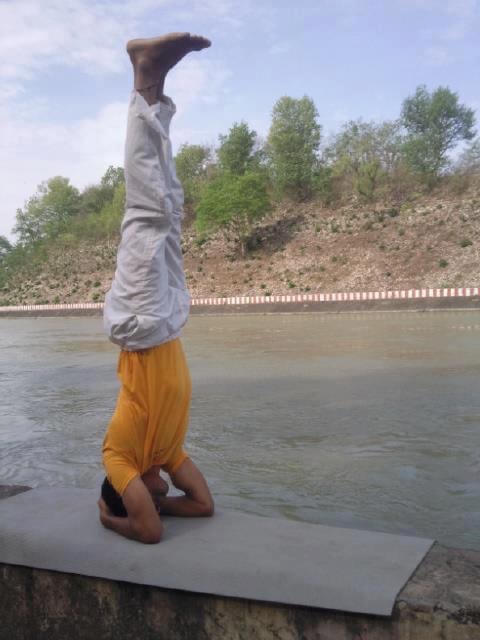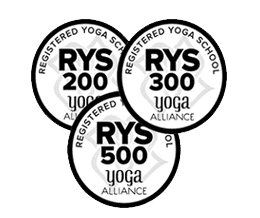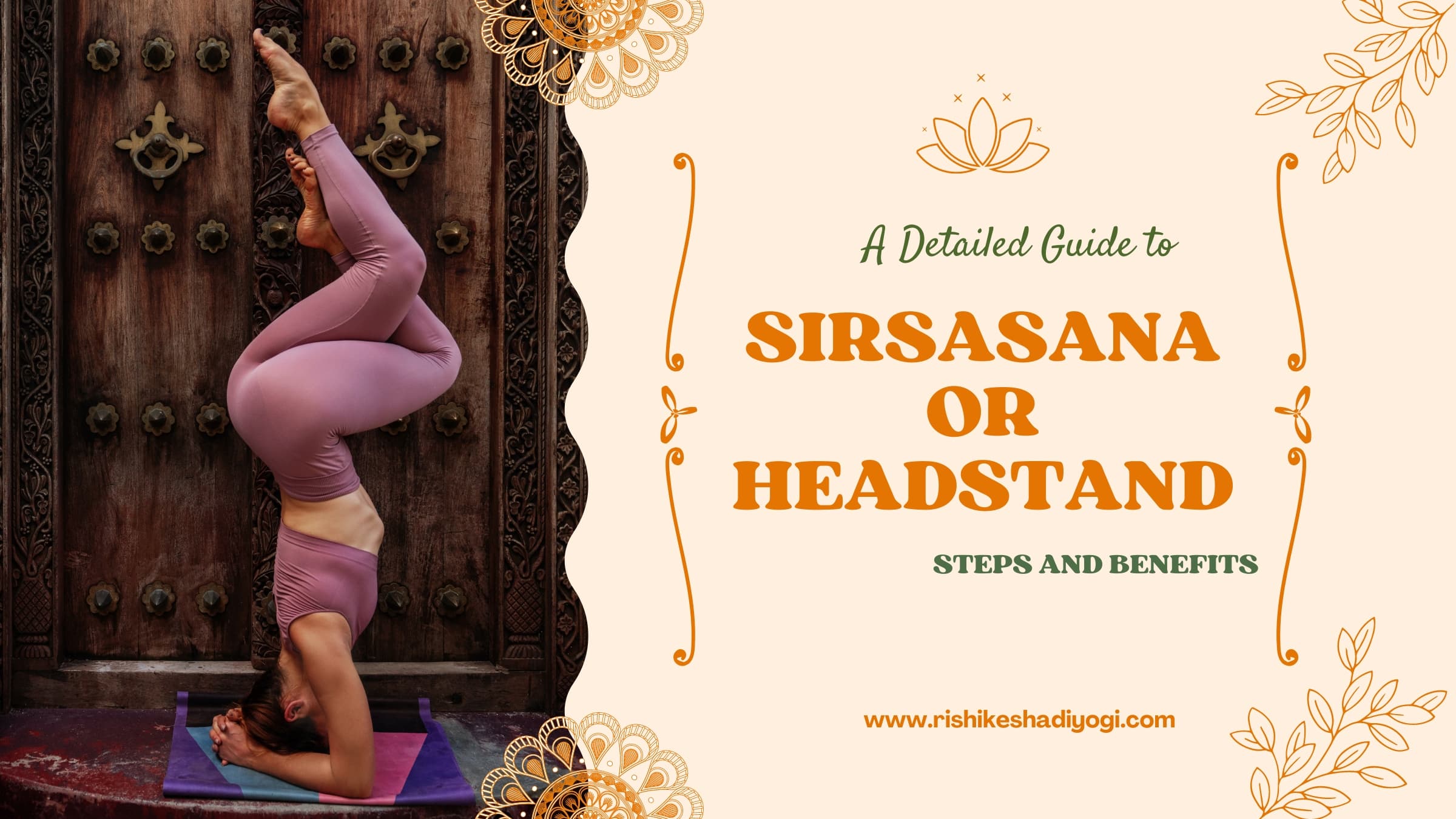Sirsasana or Headstand Pose: Steps and Benefits
Sirsasana, also known as the headstand, is considered the king of yoga asanas. This inverted pose offers numerous benefits and holds a significant place among the fundamental asanas of Hatha yoga. In Sirsasana, the body stands in an upside-down position, supported solely by the crown of the head. It is often said, “Wonderful things do not come easily,” and the same holds true for the benefits of practicing headstand and mastering it. Indeed, Sirsasana is one of the most challenging poses to conquer, requiring guidance, strength, precision, concentration, and consistent practice to attain mastery in this beautiful yoga asana.
During a 200 hour yoga teacher training in Rishikesh, aspiring yoga teachers learn not only how to perform Sirsasana safely but also how to teach it effectively to their future students. The training provides insights into proper adjustments, modifications, and variations to cater to individual needs and abilities. But don’t worry; we have curated a guideline for you to perform a headstand. It is also a beginner’s guide to performing a headstand.
how to do Sirsasana or Headstand Pose

If you are a beginner, performing headstands might take time. But do not lose hope; keep practising. And if you practice yoga and still find it difficult to do Sirsasana, these steps will help you. Grab a yoga mat and a place near a wall to practice Sirsasana.
To Build A Base for Sirsasana Pose
- First, remove glasses, bangles, scarves, a watch, bracelet, or anything that may fall during the practice or come in between. Fold the mat using the edge and keep it near the wall. You can use a blanket if you don’t have a mat.
- Sit in Vajrasana pose on the mat. To sit in Vajrasana, kneel on the mat and sit on your legs.
- While in Vajrasana, bend forward and place your forearms and arms straight in front. Spread your knees and ensure the big toe touches the mat and the hip rests on the heels.
- Keep elbows shoulder-width apart and interlock your fingers. Create a bowl-like structure using your hands to hold your head.
- Bend forward to place the top of the head on the ground, and the back of the head should be between palms.
- Ensure the shoulders don’t put much pressure on the head and neck. You can move your head side to side a few times to check.
Raising the Body in Sirsasana
- Slowly lift knees, and shoulder blades off the ground and hips in the air.
- Bring your feet together and close to your face to get your back and head straight. Thighs will get aligned against the stomach.
- Now, slowly start lifting your legs from the ground. Bend your knees and lift your legs. You can also practice this with one leg at a time. It will warm up your muscles to practice with both legs.
- Slowly lift both your legs with feet together, and toes are pointing upward/outward. Do not lose focus here; it will help you balance the asana. Focus on your breath, and you are in the Sirsasana.
Coming out of Sirsasana
- Once you are done, bring your knees slowly to the chest, and start bending your hips until your knees are closer to the chest while focusing on your breath.
- Lower one toe at a time to touch the ground. Keep your knees and back straight. You will return to your knees and hands position.
- Now, slowly bend your knees and start lowering your hips. Keep lowering your hips until your weight is not transferred to your legs. Bring the torso to the ground to attain the child’s pose. Stay in this for a while to relax.
- Now, come to the initial position of Sirsasana.
- A little stretching is recommended before and after performing Sirsasana. It helps muscles get ready for the pose and relax after performing it.
Preparatory Pose
To warm up and prepare your body for this asana, one might begin with Surya Namaskar, mainly if the asana is practised in the morning. Tadasana, Adho Mukha Svanasana, Bharadvajasana, and Prasarita Padottanasana may be practised in a series before practising Sirsasana. After completing the Sirsasana, you can do the following positions, Balasana, Sarvangasana, and Savasana may rest the body after executing a demanding asana-like headstand.
Modification & Variations
The most common headstand modification and variation are for those who have difficulty raising their legs and extending them. In this situation, you can consider these modifications and variations:
- Practice against a wall. This modification helps learn the concept of entering and exiting a headstand. The wall may provide support as you practice your breathing methods while holding the posture. In this manner, we may strengthen our shoulders and arms despite our fear of falling.
- Consider utilizing yoga blocks or a feet-up trainer to help you perform this asana.
- Performing a headstand with straight legs. This variation is much more advanced. If you are comfortable with coming up with bent legs and have sufficient hamstring flexibility, consider practising this version. It is always vital to avoid placing weight on the head.
- If you are comfortable with your shoulders and neck, ask a partner for assistance lifting your legs.
- Support the shoulders, neck, and elbows with sufficient cushioning from blankets and pillows, or practice on a firm mattress.
Benefits of Sirsasana or Headstand Yoga
The headstand yoga pose is home to many benefits if performed daily. It plays a vital role in maintaining our health and provides healing, but if performed with proper technique and the right way. Let’s see the health benefits of Sirsasana or Headstand-
- It helps to relieve stress. Our body puts a lot of effort into circulating blood to the torso and head. Poor blood circulation leads to various ailments, including stress.
- Sirsasana helps to improve and increase blood circulation in the scalp and normalize blood pressure. The proper blood circulation in the head helps to make brain blood vessels strong. It also helps to increase concentration.
- It provides better blood circulation to the eyes. The increased blood-rich nutrients and oxygen to the eyes help to prevent eye problems.
- One of the benefits of performing Sirsasana is that it helps to regulate the digestive system and improves metabolism.
- It requires shoulder and arm strength to perform a headstand. So, it would be best if you worked on them, which makes you strong.
- Sirsasana is also said to aid weight loss.
- It helps to manage anxiety, depression, and mental fatigue.
- It improves the central nervous system’s functioning.
- It helps to improve body posture as it activates core muscles.
- Strengthen back, arms, and shoulder muscles.
Contradiction
The following individuals should not do Sirsasana:
- Children less than seven years old are discouraged from attempting this position. Their skull is soft and susceptible to injury.
- Pregnant women must avoid this. There is a great chance of falling out of the position.
- Glaucoma may increase eye pressure. Hence those with glaucoma are discouraged from attempting this position.
- If you suffer from major cardiac issues, hypertension might exacerbate the issue.
- Shoulder and neck problems should also prevent individuals from practising headstands until the injury has fully healed.
- People with serious heart conditions should prevent the Headstand pose.
- Those with osteoporosis must also avoid doing this yoga position.
- If you are comfortable with your shoulders and neck, ask a partner for assistance lifting your legs.
- Support the shoulders, neck, and elbows with sufficient cushioning from blankets and pillows, or practice on a firm mattress.
Conclusion
A headstand is a proper yoga posture if practised correctly, in a safe manner, and for the appropriate timeframe. This yoga posture should not induce mental or physical strain. It would be best to learn how to do a Headstand from a qualified, certified yoga teacher with personal experience and a thorough knowledge of the pose.




